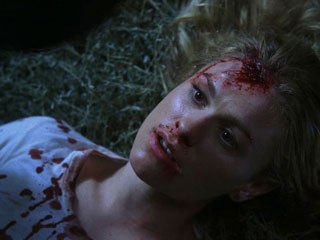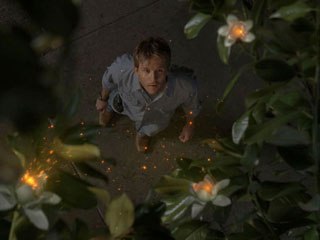Zoic Studios talks about the VFX challenges of pulling off an otherworldly vampire vibe in Alan Ball's True Blood series on HBO.
To say that writer/director Alan Ball has a uniquely skewed vision of the world is quite the understatement. The Oscar-winning screenwriter's got a way of crafting stories that manage to unearth both the gorgeous simplicities of the mundane and the garishly grotesque secrets that lie just under the surface of our everyday lives. Whether it's capturing suburbia mid-life crisis in American Beauty or extreme family dysfunction in Six Feet Under, Ball's yarns demand a viewer's attention.
When it was revealed last year that Ball's next project would be adapting novelist Charlaine Harris' successful Southern gothic vampire stories into a television series for HBO called True Blood (airing Sundays at 9:00 pm)... well, fans and critics alike went into a tizzy of excitement in anticipation for what he would do with the well worn vampire genre. And as expected, Ball hasn't disappointed.
True Blood follows the exploits of Sookie Stackhouse (Anna Paquin), a genteel Southern telepath that slings beers in a bayou bar in rural Louisiana. Vampires have recently "come out" to the world and humans are trying to figure out how to accept the pasty bloodsuckers into mainstream society. In the pilot, Sookie serves brooding vampire Bill Compton (Stephen Moyer) at the bar and lusty sparks fly. While reaction to the series has been mixed, with critics and fans split down the middle on the success of Ball's wildly explicit take on love, sex and vampirism, True Blood is definitely generating buzz and a confirmed second season.
And that's good news for Zoic Studios, the renowned visual effects company enlisted by Ball to make the otherworldly aspects of his series come to life so realistically that you'd swear vampires could be lurking just outside our doors. Visual Effects Supervisor Jon Massey and In-House Visual Effects Supervisor Andrew Orloff talk to VFXWorld about the challenges of making Ball's vision of the supernatural world come to life like audiences have never quite seen before.
Tara Bennett: When you first spoke to Alan about True Blood, what were his visual effects priorities for the series?
Andrew Orloff: One of the things that Alan said to us from the beginning is that True Blood is not an effects show. What that means is that the effects need to look as natural and organic as possible.
Jon Massey: He didn't want to do anything with the effects that would distract from the performance of the actor. He didn't want to have a vampire transition that included faces change or dramatic fangs popping out.
TB: Audiences have come to expect those cheesy vampire tropes, so how did you strip the expectations down in terms of the visual effects design?
AO: We really took it back to the idea that everything we do needs to come out of thinking about the motivation for what's happening on screen. In the case of the fang reveals, we digitally grow the teeth from the mouth of the vampire. Zoic proposed referencing how a rattlesnake uses its fangs when it attacks. The fangs extend in an arc from inside its mouth and so we used that as an inspiration to build our effect from something organic. If you watch the show, you may never actually know they are retracting or extending their fangs in an arc with their real teeth going up inside their mouth. We built it so that it is subtle and viewers may never notice it, because it looks really natural. It's all done digitally, there's nothing practical about the effect.
There are practical fangs that Masters FX created for all of the non-retracting or extending shots. For those we track the digital fangs into the live action performance. The actors don't have the fangs in when they are performing so they need to really think about the process and practical jaw movement when it's happening in the scene.
TB: How do you collaborate with Masters FX to make the practical and digital mesh so well?
AO: For every key action Zoic touches, we show just enough with the visual effects that you'll understand what happens to a vampire physiologically. A lot of those scenes have natural prosthetics done by Masters FX, which look amazing and are enhanced further with effects as needed. It all comes back to thinking of a way to do the effect like it would really look as if it were to happen in real life. We are trying to make it as real as possible on a television budget while not making it grotesque. It involves a lot of research to find the right balance.
TB: You've worked on other vampire-themed shows like Angel, so what feels different about True Blood?
AO: True Blood is really a different take on vampire mythology, much different from the work we did on shows like Buffy [the Vampire Slayer] and Angel and Blade. Based on our previous experience, we have these ideas to draw from, while embracing a certain subtlety. There are no heavy magic elements to go over the top with, and that has offered something different and exciting -- a dramatic tension that comes with operating within a scope of "real." And it's a fun show to work on. It's great working with Alan Ball because he has a strong, clear vision but is also open to our ideas.
TB: About how many vfx shots is Zoic producing per episode of True Blood?
AO: As for the number of shots per show, it really varies from episode to episode. The first few episodes were light but as the series progresses and we go deeper into the vampire world, we are staffing anywhere from a team of five to a team of 10 artists on the show. We're doing everything from heavy CG to a lot of compositing. Production filmed in Shreveport, Louisiana to get many of their exterior shots and also to get plates for a lot of the driving sequences.
TB: Are there software packages your team is particularly relying on to meet the creative and deadline demands for True Blood?
AO: Every package has plusses but we tend to use software packages that lean more towards the strengths of the artists on the show. Some particular processes call for different packages like an upcoming transformation for which we are developing a pipeline in Maya for After Effects.
For the fangs and 3D effects we use Maya for the setup and SythEyes for tracking. We're rendering using a proprietary mental ray pipeline that lets us have full control in comp of all the CG renders. We also developed a new performance capture technique on the show that allows us to take 2D tracking data from an actor's face and place it onto a 3D model for use in some of the more complex digital prosthetic shots. We also did a bunch of smoke replacement and enhancements throughout the show utilizing a variety of techniques, including Particle Illusion and Maya fluids.
JM: Luckily with this show, we are working so far ahead. It's unlike the other network shows we work on which have a much more aggressive delivery. In that way, True Blood actually feels more like a hybrid of a TV show and a feature film, and hopefully it reads that way to the audience.
Tara Bennett is an East Coast-based writer whose articles have appeared in publications such as SCI FI Magazine, SFX and Lost Magazine. She is the author of the books 300: The Art of the Film and 24: The Official Companion Guide: Seasons 1-6.











